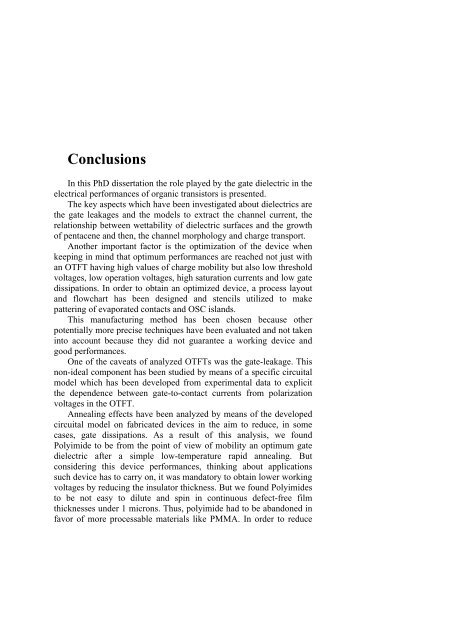tesi R. Miscioscia.pdf - EleA@UniSA
tesi R. Miscioscia.pdf - EleA@UniSA
tesi R. Miscioscia.pdf - EleA@UniSA
Create successful ePaper yourself
Turn your PDF publications into a flip-book with our unique Google optimized e-Paper software.
Conclusions<br />
In this PhD dissertation the role played by the gate dielectric in the<br />
electrical performances of organic transistors is presented.<br />
The key aspects which have been investigated about dielectrics are<br />
the gate leakages and the models to extract the channel current, the<br />
relationship between wettability of dielectric surfaces and the growth<br />
of pentacene and then, the channel morphology and charge transport.<br />
Another important factor is the optimization of the device when<br />
keeping in mind that optimum performances are reached not just with<br />
an OTFT having high values of charge mobility but also low threshold<br />
voltages, low operation voltages, high saturation currents and low gate<br />
dissipations. In order to obtain an optimized device, a process layout<br />
and flowchart has been designed and stencils utilized to make<br />
pattering of evaporated contacts and OSC islands.<br />
This manufacturing method has been chosen because other<br />
potentially more precise techniques have been evaluated and not taken<br />
into account because they did not guarantee a working device and<br />
good performances.<br />
One of the caveats of analyzed OTFTs was the gate-leakage. This<br />
non-ideal component has been studied by means of a specific circuital<br />
model which has been developed from experimental data to explicit<br />
the dependence between gate-to-contact currents from polarization<br />
voltages in the OTFT.<br />
Annealing effects have been analyzed by means of the developed<br />
circuital model on fabricated devices in the aim to reduce, in some<br />
cases, gate dissipations. As a result of this analysis, we found<br />
Polyimide to be from the point of view of mobility an optimum gate<br />
dielectric after a simple low-temperature rapid annealing. But<br />
considering this device performances, thinking about applications<br />
such device has to carry on, it was mandatory to obtain lower working<br />
voltages by reducing the insulator thickness. But we found Polyimides<br />
to be not easy to dilute and spin in continuous defect-free film<br />
thicknesses under 1 microns. Thus, polyimide had to be abandoned in<br />
favor of more processable materials like PMMA. In order to reduce
















